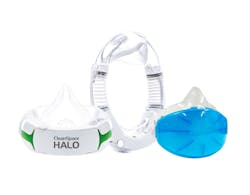Moving on in the second year of the COVID-19 crisis, you see hospitals, intensive care units (ICUs) and other essential healthcare providers continuing to combat obstacles in patient care, supply management and infection control in their settings.
On one hand, the situation looks brighter, with more vaccine shots in arms to slow the spread of the SARS-CoV-2 virus, which causes COVID-19. On the other hand, the pandemic shows no apparent signs of ending, with variants detected in several locations, relaxing public health safety measures, rising infection cases and increased care needs.
This all, of course, strikes a blow to the health and well-being of healthcare workers, patients and families, as well as the stability and bottom line of hospital and healthcare operations.
Frontline workforce hit, help
First, for example, ICU physicians and staff remain stretched thin in many areas across the U.S.
The George Washington University reported, “analysis shows that ICU doctors in…209 counties will be taking care of more than 24 severely ill patients at one time. Typically, an ICU doctor will care for half that number of patients or less at the same time—and, at 24 or higher, hospitals will have to quickly organize and train non-ICU providers to step in and help provide care…Hospitals can create a new COVID-19 unit by taking over an underused floor or wing, but they have more difficulty finding trained doctors and others to fill in when health care workers get sick or must quarantine.” 1
At Baptist Medical Center, part of Baptist Health Care System in San Antonio, TX, adding more capacity to care for patients with COVID-19 increased pressure on staff, supplies and equipment, explains the hospital’s Critical Care Director Connie Thigpen, MBA, RN, a recipient of a 2021 Circle of Excellence award from the American Association of Critical-Care Nurses.2
“My ICU quickly expanded from 30 to 56 beds,” Thigpen indicated. “We had a few supplemental staff in the form of crisis nurses when we started to hit those peaks, but not enough to keep our staffing loads the same as before the pandemic. Instead of the usual one to two patients per ICU nurse, we were all providing care to four COVID-19 patients each in the ICU.
“In addition to the expected PPE-related issues, other material items quickly became issues,” she continued. “We took over an 18-bed post-anesthesia care unit and reopened a closed unit that was once an eight-bed ICU. We were challenged to find the additional beds, flow meters, suction heads, monitoring cables, and all the basic components needed to set up a room to receive a patient. And that is not even touching on ventilators, hi flows, and bipaps. Whenever we placed equipment orders, we faced extraordinarily long wait times for delivery.”
Medical workers continue to endure extended responsibilities and hours caring for such critically ill patients in environments heightened by infection risk.
Asilinn La Brie, RN, BSN, MBA, Senior Consultant in Business & Clinical Optimization, Cardinal Health, points to several conditions healthcare staff have faced during care and the pandemic, including:
• “Working with the fear of becoming infected – and exposing others
• Shortage of critical personal protective equipment (PPE)
• Elevated workloads and high patient-nurse ratios
• Fewer support staff and maybe even fewer on-call staff
• Shifts that did not allow time to disconnect, while taking on more responsibilities when managing patients with COVID
• Emotional and physical stress and exhaustion
• Inability to provide psycho-social care to patients and families
• Protocols frequently changing; some new cleaning protocols placing greater burden on clinicians and requiring them to take on additional duties.”
Health and wellness support, consequently, has transpired as a need among healthcare personnel to help cope in the crisis.
For example, “A new article in The Joint Commission Journal on Quality and Patient Safety…details how Montefiore Medical Center – located in the Bronx, the borough hardest hit by COVID-19 in New York City – implemented various mental health services to mitigate and treat psychological distress among staff. Interventions implemented during the pandemic included:
• Psychoeducational resources (including invited presentations, grand rounds and web-based resources)
• Telephone support line
• Staff Support Centers (SSCs)
• Clinical treatment program
• Parenting skills and support groups
• Team support sessions
• Peer support outreach
• Mental health and wellness programs
• Clergy support,” addressed The Joint Commission.”3
PPE access plummets, pivots
Safeguarding medical teams from COVID-19 and other infections within healthcare settings requires ongoing focus on PPE. That means maintaining a steady flow of supply for all staff at all times. The pandemic, however, has caused major breaks in the supply chain.
“Healthcare systems worldwide have worked under challenging conditions during the COVID-19 crisis,” emphasized David Phillips, Marketing Manager, Hänel Storage Systems. “The lack of adequate PPE supplies caused anxiety, insecurity and fear of infection. PPE was in such short supply that nurses would often develop homemade solutions to protect themselves. So many supplies had to be immediately discarded at the start of the pandemic because they had been expired by several months when they were needed most.”
Phillips suggests implementing centralization and automation within inventory management systems to help improve access to supplies and workspace.
“Centralizing PPE supplies will take those items out of the various departments in which they’re currently located, which will free up much-needed space in those areas. A Hänel Rotomat automated carousel, specifically designated for critical supply, can act as an ‘automated PPE czar’ to the provision of supplies for each area as needed. This ensures the efficient use of PPE stockpiles, tracked by expiration dates, so the next health crisis won’t catch hospitals shorthanded as they were at the start of COVID-19.”
Face masks, in particular, are a high priority for staff protection and infection control in hospitals and other environments.
Officials at the Henry Ford Health System cited, “A study published in the Journal of Occupational and Environmental Medicine from researchers at Henry Ford Health System has found that Henry Ford’s early implementation of a universal mask policy in the COVID-19 pandemic was strongly associated with reducing the risk of healthcare workers at Henry Ford acquiring COVID-19.”
The system added, “Healthcare workers have a threefold increased risk of reporting testing positive for SARS-CoV-2…compared to the general population, according to a study published in Lancet Public Health. As of March 22, 2021, the Centers for Disease Control and Prevention (CDC) has reported more than 450,000 SARS-CoV-2 infections among healthcare workers in the U.S. since the onset of the pandemic, and nearly 1,500 COVID-19 related deaths among healthcare workers.”4
Personnel in facilities, such as Baptist Medical Center, learned to change their practices around PPE as COVID-19 surfaced, notes Thigpen.
“When COVID-19 first reached San Antonio, some staff were hesitant to adjust long-held protocols, especially around the extended use of PPE,” Thigpen expressed. “Throughout all of our nursing careers, we had been trained that some items were single-use or were to be used only so many times, or that one item was not a substitute for another. Suddenly, we were being told to wear the same N95 mask for multiple shifts when for years we had been rigidly told to change any PPE between patients. We were also told that doing so would be okay and would maintain the same amount of protection.”
The facility’s communication and guidance about the disease and prevention helped ease mindsets and develop new behaviors among the workforce, adds Thigpen.
“We needed to mitigate staff concerns about changing standards and potential shortages for PPE and then shore up their confidence as much as possible with good information and clear communication,” she stressed. “As more information became available in the form of manufacturers’ recommendations, official updates and infectious disease data, we were able to focus our COVID-19 staff education on what was working in other parts of the country. Attitudes began to shift, and we achieved greater buy-in and support from staff.”
As availability of disposable face masks may shift at times, some hospitals and providers have opted for other types of face protection supplies that can be disinfected and reused, indicates Jon Imms, Global Technical & Product Director, CleanSpace Technology.
“The COVID-19 pandemic has highlighted the global challenges for the supply of disposable N95 masks and the widespread issues for poorly fitted and uncomfortable masks,” Imms stated. “The issue of comfort has been illustrated in reports of staff complaining of moisture on the face, heat stress, fogging of eyewear and deep marks on the face at the end of a shift. Being uncomfortable, disposable masks also lead to low compliance. With active airflow, CleanSpace HALO offers a high level of protection, provides cool, fresh air on the face, eliminates fogging of eye wear, and the clear transparent masks allow for easy communication.”
Care, supply collaboration
While hospital and healthcare staff have experienced many challenges during the pandemic, they also have achieved several successes through partnership with their teams, supply chain and facilities.
Take, for instance, the collaboration between Baptist Medical Center’s ICU and Central Supply department. Together, they made strides in efficiencies in care and supply management.
“When I became director during our peak last summer, we did not have a handle on supplies and, basically, it was purely crisis control,” Thigpen described. “Having a good working relationship with our facility’s Central Supply and developing an initial game plan got us started and maintained supplies funneling into our 56 COVID-19 ICU beds that were scattered over five areas. Our Central Supply staff and management were amazing; they established a designated rack in the Central Supply department, from which we restocked our daily supply needs and essentials. We adjusted the baseline stocking levels that Central Supply used for reordering several times over to accommodate the increased amount of tubing, flushes, needles, lab supplies, etc., required to take care of the massive consumption required by COVID-19 patients.”
She continued, “Our most amazing success was the reconfiguration of the post-anesthesia care unit we took over. The PACU supply closet was tiny and too far removed from the bays that we had converted to ICU beds. We set up placards and racks in the very front of the entry, which were filled with item lists generated by ICU staff, were physically arranged by ICU staff and allowed easy, open and immediate access. Staff could also easily create lists for Central Supply to restock based on this open format, which was a necessity as there was not a room large enough to hold what the ICU required.”
La Brie points to Supply Chain and Nursing partnering to improve medical supplies and pathogen control in a hospital system.
“At one 15+ hospital system, the Cardinal Health Sales team collaborated with key members of the Supply Chain and Critical Care Nursing teams to help them standardize to Kendall Disposable Cables and Lead Wires,” La Brie indicated. “The Supply Chain team was thrilled to learn that switching to Kendall DL could help them eliminate more than 20 types of lead wires used across the system by standardizing to one SKU. Both groups of stakeholders were aligned and motivated by the fact that this clinically proven product helps reduce the risk of cross contamination (according to the American Journal of Infection Control).”
Imms highlights another health system’s work to protect staff from infection spread through new PPE.
“Parkview Health is a US Health system serving a population of more than 895,000,” Imms described. “Parkview has more than 13,000 employees, nine hospitals and a network of primary care and speciality physicians. Alyssia Mickem, Safety Supervisor for Parkview Allen County, said they chose CleanSpace Respirators as their respirator of choice during the COVID-19 pandemic, because ‘Safety is Parkview’s highest priority with their employees, with their patients, with their visitors, and this does offer the highest protection.’”
Caring on
So, with all the odds stacked up against them in the continuing pandemic, how will hospitals and healthcare facilities fare in patient care?
The outlook, currently, shows a financial toll will occur this year, according to “new analysis prepared by Kaufman, Hall & Associates, LLC and released by the American Hospital Association (AHA),” 5 reported AHA.
• “Even under the most optimistic scenario with a smooth vaccine roll-out and reduced COVID-19 hospitalizations, on average, 39% of hospitals would operate in the red in 2021, a marked increase over pre-pandemic baselines, according to Kaufman Hall data. Under this scenario, median hospital operating margins would be 10.5% down from pre-pandemic baselines in 2019. Before COVID-19, the median hospital margin was a modest 3.5%.
• “In the most pessimistic scenario, on average, half of hospitals would operate in the red in 2021, with median margins down 80% from pre-pandemic baselines.
• “For rural hospitals, the most optimistic scenario would result in median margins that are 38% down from pre-pandemic baselines, with the most pessimistic scenario resulting in a 100% decline from baselines.” 5
Still, there is a glimpse of advancing care and safety as new technology makes its way to bedsides.
For example, “Hackensack Meridian JFK University Medical Center is the first hospital in New Jersey to operate a new portable MRI that can be wheeled to the bedside of critically ill patients…The Swoop Portable MR Imaging System is made by Hyperfine Research,”6 announced Hackensack Meridian JFK University Medical Center.
“Some of the potential advantages of mobile MRI include:
• “Scanning patients in the Emergency Department, decreasing wait times and speeding diagnosis
• “Scanning COVID-19 patients at the bedside, decreasing the risks of transporting infectious patients through the hospital
• “Improved monitoring of patients in the Neuro Intensive Care Unit as they recover.”
Additionally, CareView Communications, Inc. announced a “three-year agreement with Maury Regional includes CareView’s latest Gen 5 hardware and software offerings, which includes a variety of camera solutions specifically designed to address clinical needs in general safety, applications for use in ICUs, behavioral health settings, and negative pressure COVID-19 units. CareView’s solution for reducing patient falls and increasing in-room patient safety is a scalable design that delivers operational savings in any application.” 7
The supply chain-clinical partnership on products needed can help enhance operations and care, suggests La Brie.
“The Supply Chain and Critical Care Nursing teams should connect with key suppliers, where applicable, to create a comprehensive plan,” La Brie recommended. “As each situation is fluid, the goal should be to ensure an atmosphere of visibility and openness with supply chain and clinical staff. The teams should have a plan in place that provides concise, consistent and frequent communication in any future pandemic or emergency care.”
She continued, “Several elements impact how these teams can perform most effectively together, including:
• Standardized process and products: standardizing patient care can lead to more consistent patient outcomes as well as improved efficiency
• Visibility to product inventory
• Built-in time for the staff to take a breather; with increased cleaning protocols and higher nurse-patient ratios, it is essential for clinicians to have breaks for physical and mental wellbeing.”
Industry regulations for adequate supply of PPE on site are coming, indicates Phillips.
“There will soon be state deadlines that require hospitals to have at least a minimum amount of PPE on hand,” Phillips noted. “Once that amount is met, the inventory will need to be accurately tracked and managed. Even though there is a light at the end of the tunnel with the current pandemic, there will always be healthcare events that need isolated supplies.”
References:
1. 209 US Counties Face a Crisis in Staffing ICUs that Care for COVID-19 Patients, Online tool launched today by George Washington University and partners, March 04, 2021, https://mediarelations.gwu.edu/209-us-counties-face-crisis-staffing-icus-care-covid-19-patients
2. https://www.aacn.org/newsroom/class-of-2021-circle-of-excellence-recipients-announced
3. Mental health support for health care workers during COVID-19 pandemic, https://www.jointcommission.org/resources/news-and-multimedia/news/2021/02/mental-health-support-for-health-care-workers-during--covid-19-pandemic/
4. Henry Ford Study Shows Face Masks Strongly Associated With Reducing Healthcare Workers’ Risk of Acquiring COVID-19, March 26, 2021, https://www.henryford.com/news/2021/03/universal-masks
5. Hospital & Health System Financial Health in 2021, WASHINGTON (March 23, 2021), https://www.aha.org/press-releases/2021-03-23-new-analysis-shows-continued-negative-impact-covid-19-hospital-health
6. JFK University Medical Center First Hospital in New Jersey to Utilize New Portable MRI, March 25, 2021, https://www.hackensackmeridianhealth.org/press-releases/2021/03/25/jfk-university-medical-center-first-hospital-in-new-jersey-to-utilize-new-portable-mri/
7. CareView Communications, Inc. Executes Hospital Agreement with Maury Regional Medical Center, Posted on March 23, 2021, https://care-view.com/careview-communications-inc-executes-hospital-agreement-with-maury-regional-medical-center/

Ebony Smith
Ebony Smith was previously Managing Editor for Healthcare Purchasing News.








